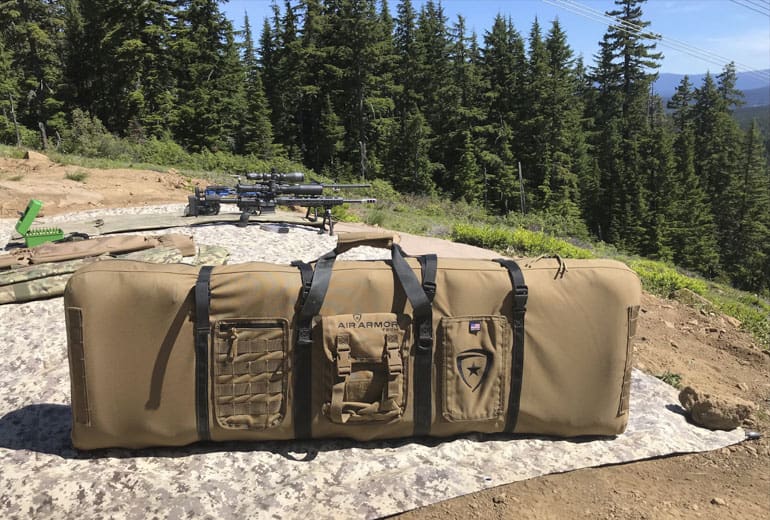
In 2017, Air Armor Tech released its innovative line of inflatable rifle cases. These offer the same level of protection as a hard case, but in a lightweight package that rolls up into a sleeping-bag-sized package. I’ve had this T&E sample for 18 months, which is longer than we usually take to test products, but I wanted to make sure that this thing was durable over the long haul before I gave it a thumb’s up.
It’s no secret that long-range precision rifles are expensive. It’s not difficult to shell out $5K-10K or more on a quality set-up. With that kind of investment, it makes sense to transport your rifles in a high-quality, impact-resistant rifle case.
I own at least 15 hard cases, including samples from Pelican, Hardigg, Zero Halliburton, and others. These cases take up a ton of storage space:
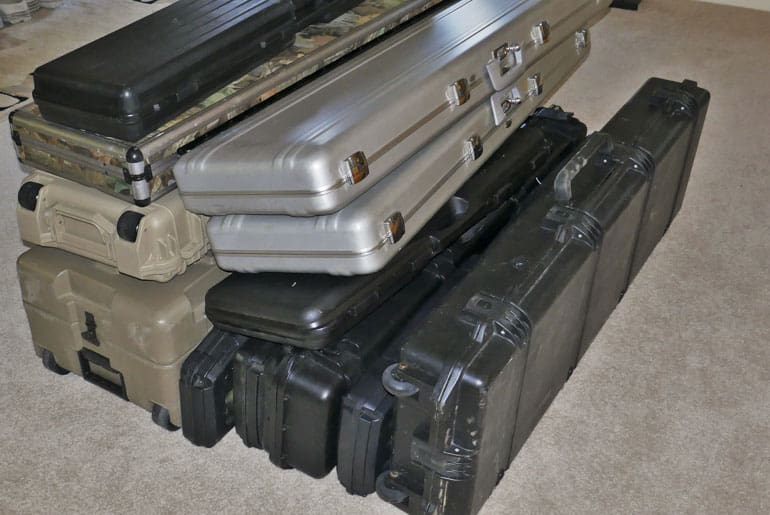
Air Armor Tech addressed this problem by adapting technology that they perfected while designing helmet bags made for the F-35 fighter.
According to Air Armor Tech’s founder and CEO, Blaine “Rock” Tompkins, modern fighter pilot helmets cost Uncle Sam somewhere between $200,000 and $500,000, depending on the model. He should know, because he has logged over 17,000 hours in the F/A18 Hornet, the F-16 Viper, and the F-35.
He invented the protective helmet case to address the problems he experienced with then-existing technology.

The heart of the system is a single clam-shell air bladder that is three inches thick on each side when fully inflated. I was initially very skeptical that this thing would work. I assumed the bladder would eventually leak.
The 200 denier, urethane-coated bladder closely resembles my inflatable backpacking sleeping pads, except this bladder is much more heavy-duty (typical sleeping pads are 20D to 75D). After 18 months and 50+ range trips, I’m now convinced that this thing is legit in terms of how rugged it is.
And frankly, it better be, because with a $550 MSRP, they obviously aren’t cheap. I guess the “buy once, cry once” rule applies.
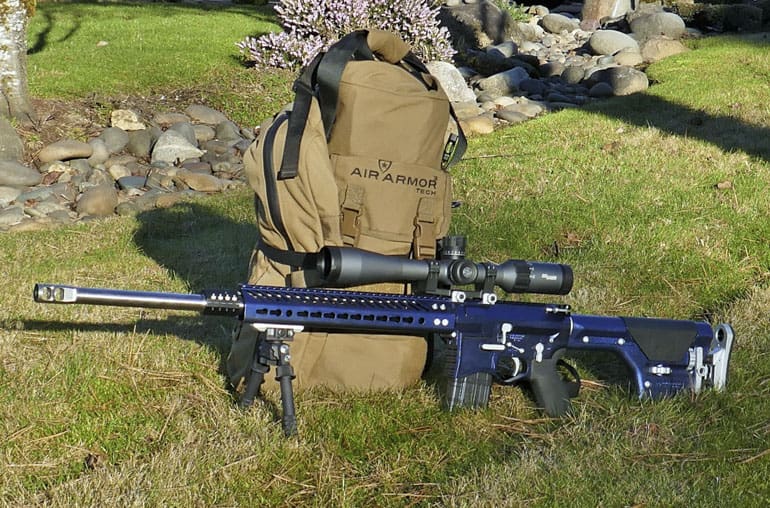
I really like that this case is relatively lightweight (10 lbs) and that it’s fairly compact when rolled up (roughly 19” x 10” x 10”). For me, those features really make it worth the price of admission.

The case will hold two long guns. It will easily accommodate a larger chassis rifle and something smaller like an AR-15. If you shoot 3-gun, you could use this case to transport the shotgun, carbine, and the pistol. In the photo below, you can see how a custom AR-15 with a 26-inch barrel fits in the case:
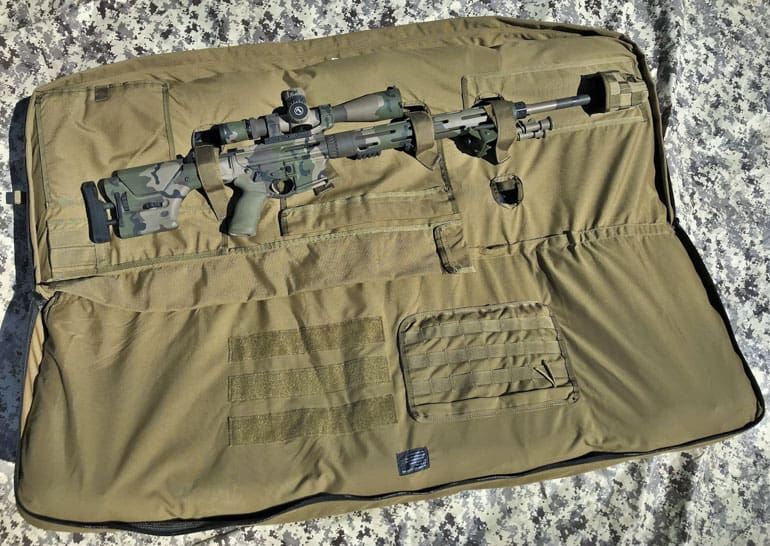
A closer view shows three of the four retention straps in operation. These straps are important for ensuring that the rifle doesn’t move around in the case, which, in turn, helps ensure that the bladder provides the best protection for the rifle.
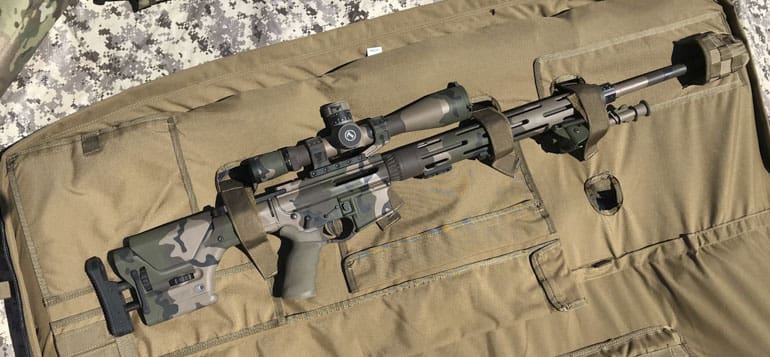
The outer shell is made of 1,000 denier urethane-coated nylon, which provides both good durability and optimal weather resistance. The inner shell is made from 500 denier urethane-coated nylon.
As part of my testing, I left the case on my pouch overnight in a rainstorm with notebook paper in the inside, and I was pleasantly surprised to find out that the paper was still dry in the morning.
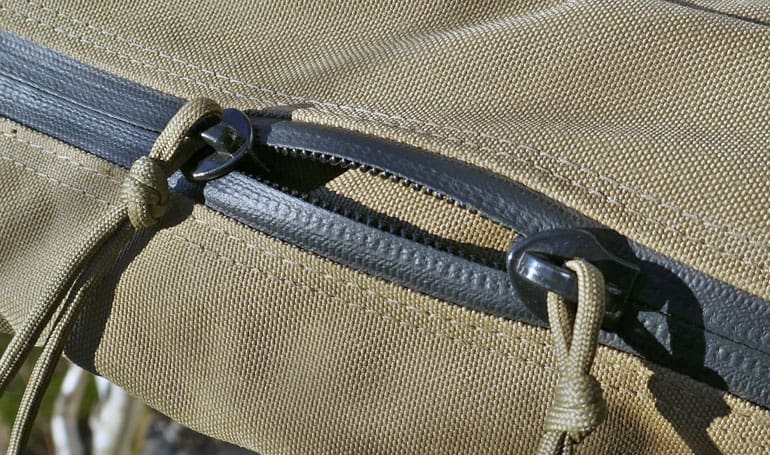
Air Armor Tech uses top-of-the-line YKK water-resistant zippers with marine-grade, 316 stainless-steel slider These are big zippers which are rated for 330 lbs of crosswise break strength.
External Features

As shown in the above photo, the Air Armor Tech long case is festooned with external pockets, MOLLE attachment points, and retention straps. Once opened, the case can also be used as a shooting mat or sleeping pad.
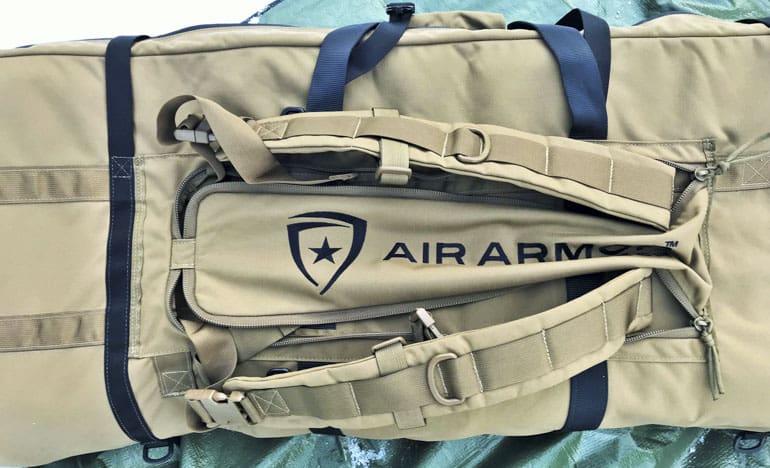
The Air Armor Tech case comes with padded shoulder straps, which allow the operator to carry the case as a backpack for hands-free carry. This is very convenient when you’re trying to limit the number of trips from your vehicle to the shooting bench or hunting stand, etc.
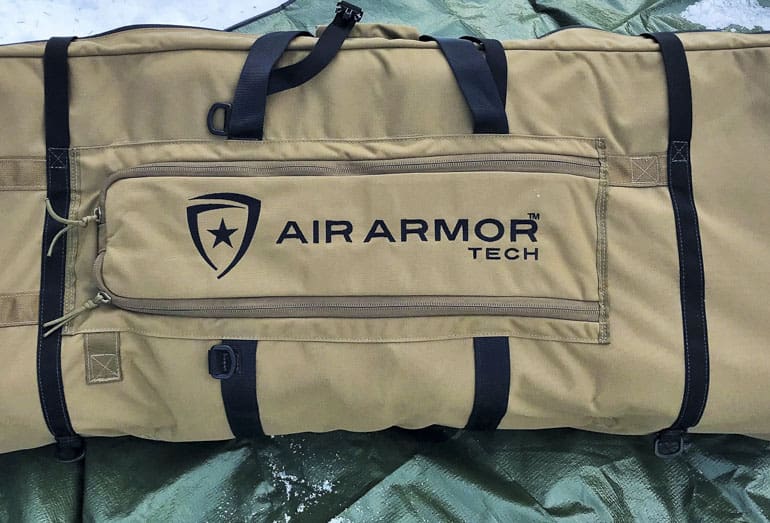
The case features four (4) lateral straps with 1” mil-spec side release buckles. The case also has four 1” D-rings which the website says is “certified for military use.” I’m not sure how to verify that, but the D-rings are useful when you roll up the case for storage.
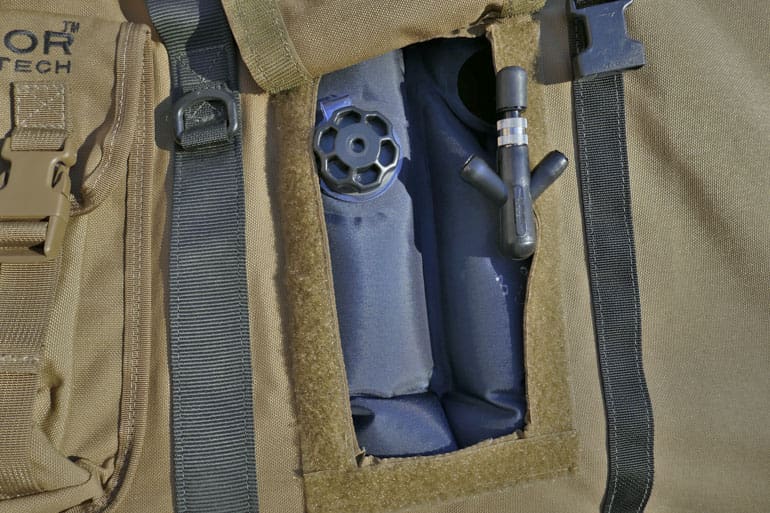
There is a Velcro panel on the outside of the case that is used to access the air bladder. The main valve in the center is the oral inflation valve. You can press and blow into this valve to inflate the product. Additionally, you can also use an air compressor with a blow gun attachment to inflate the case through this valve. The black rubber ball valve is used for inflation with a product that can accept an inflation needle like a recreational ball pump or bike tire pump.
The third valve, with the white mechanism inside, is the automatic pressure relief valve. This valve will activate at or above approximately 5.4 psi to bleed off pressure to prevent bladder damage and will close automatically once a safe pressure is reached.
Gusseted Accessory Pocket
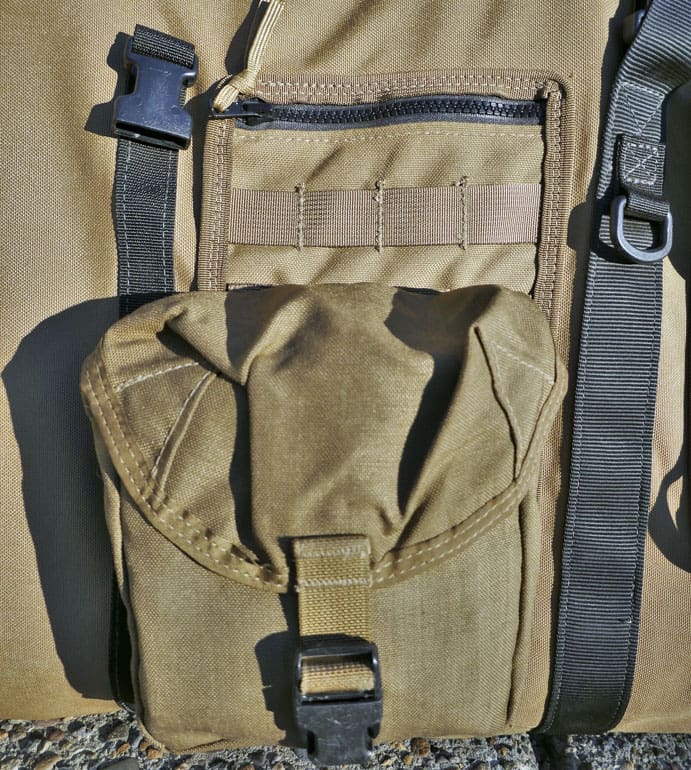
The expandable pocket is great for magazines and ammunition, or other things that don’t need to be protected from extreme impacts.
Zippered MOLLE-Clad Pocket
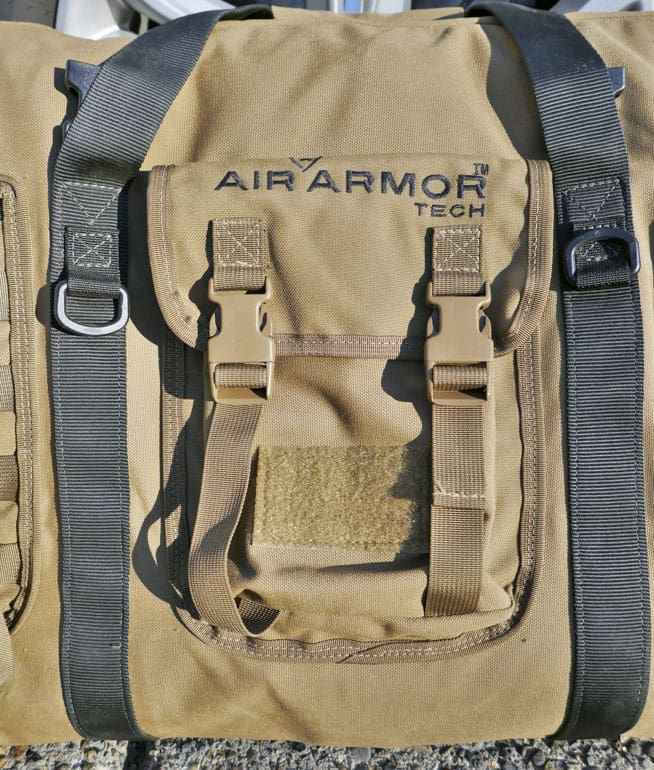
On one occasion, I attached a military canteen to the MOLLE pocket, because I knew that I was going to have to pack the rifles into the shooting location, and I was trying to limit the number of trips I was making to the shooting location.
MOLLE Attachment Points
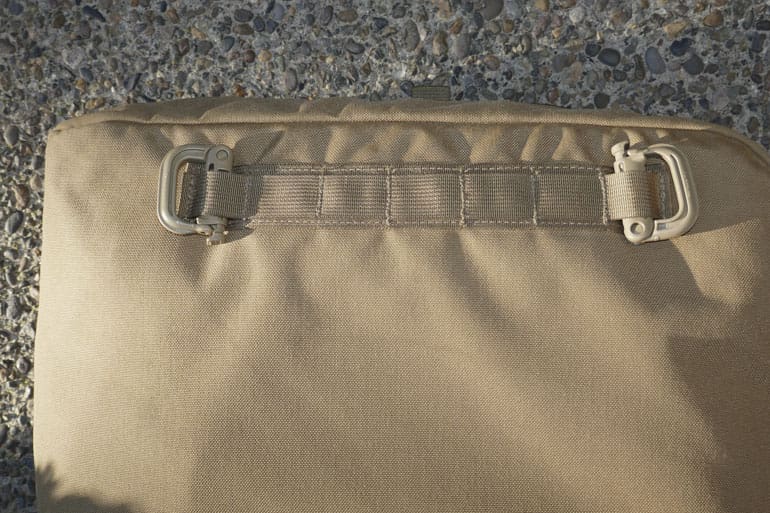
The Air Armor Tech Long Gun Case has a strip of MOLLE sewn into the ends of both sides of the case. I added some plastic non-load bearing snap-links that I found at an army surplus store. These snap links allow me to store this case from the ceiling in my garage.
Internal Features:

The inside of the Air Armor case is well laid out in order to accommodate two long guns, ammo, pistols, binoculars, etc. In the photo above, I’m using the AAT to transport my Mausingfield on a cold winter day. The following photos highlight the key features:
Barrel Sleeve
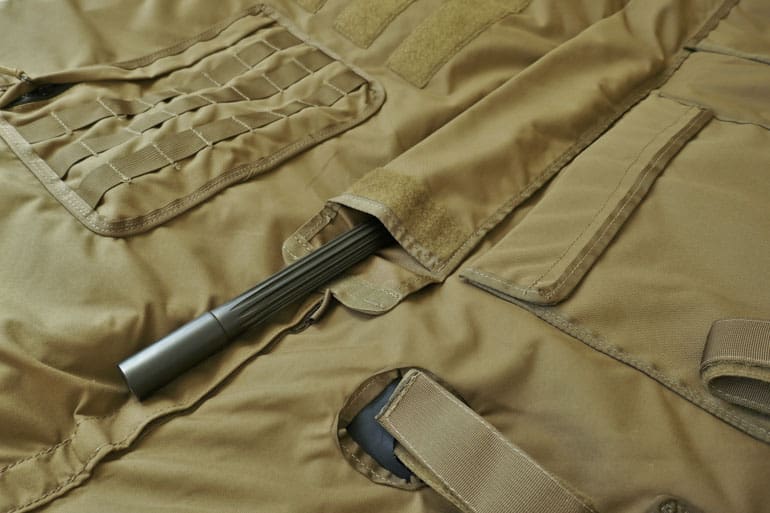
The 32” x 4” barrel sleeve is useful when you are transporting rifles such as the CZ 455 which feature interchangeable barrels. I also found also useful for transporting full-length cleaning rods in their original packing tubes.
Velcro Multipurpose Pocket
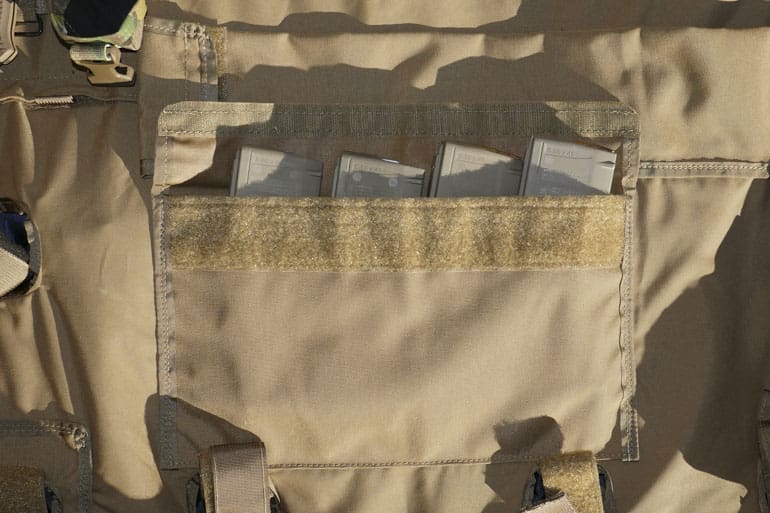
A large (13” x 9”) Velcro-closed pocket is located in the center of the case, and is ideally suited for optics, rangefinders, or other items that need impact protection. It is not big enough for a large spotting scope such as my Leica Televid 77, but a Leupold Golden Ring 20-40×60 spotting scope fits perfectly in this pocket.
Zippered MOLLE-Clad Pocket
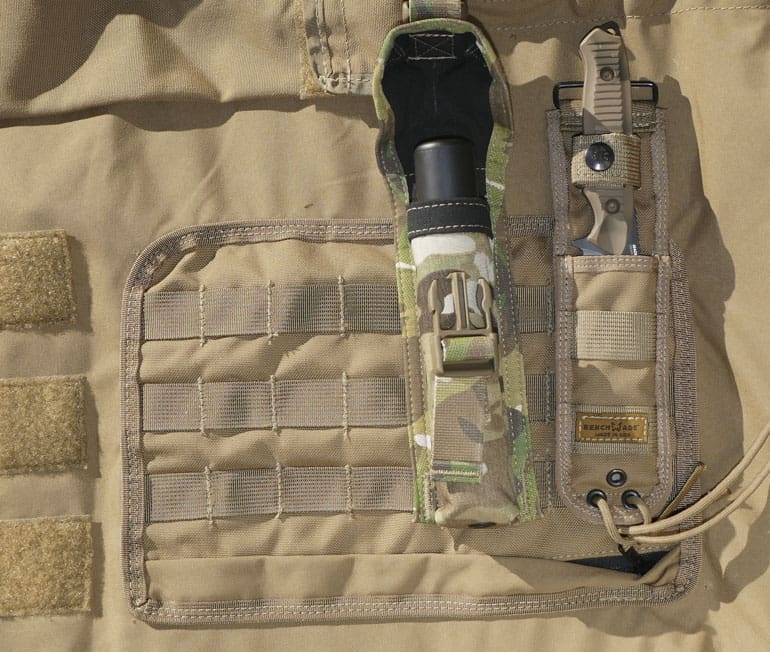
The 8” x12” zippered MOLLE pocket is a great place to store the repair kit that comes with the case.
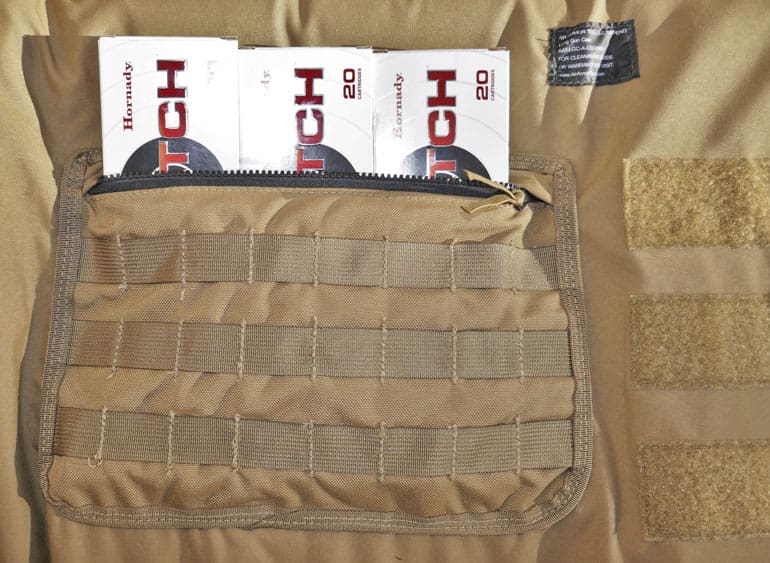
It also fits AR-15 sized magazines, three boxes of rifle ammunition, a cleaning kit or tool kit. I attached one a suppressor pouch and a Benchmade Nimravus knife to the MOLLE attachment points.
Velcro Pistol Pocket
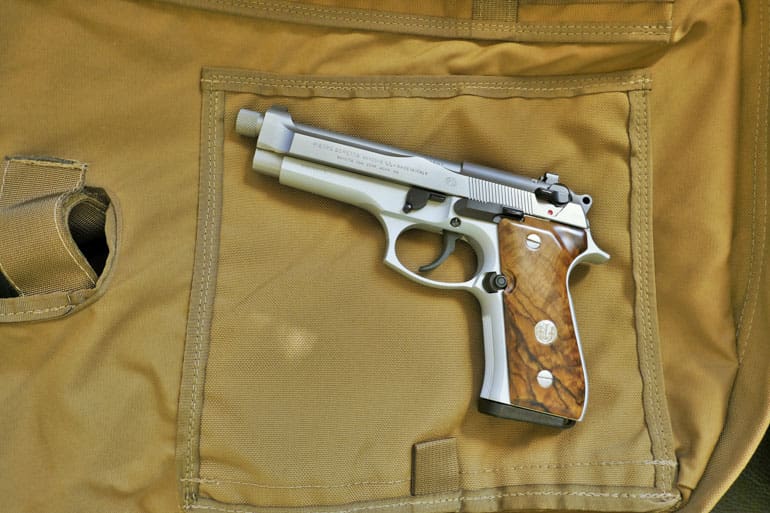
The 9” x10” pistol pocket will easily carry a full-sized 1911, Beretta 92FS, or similarly-sized handgun. It will also hold six AR-15 magazines, ammunition, binoculars, cleaning kits, etc.
Velcro Loop Strips
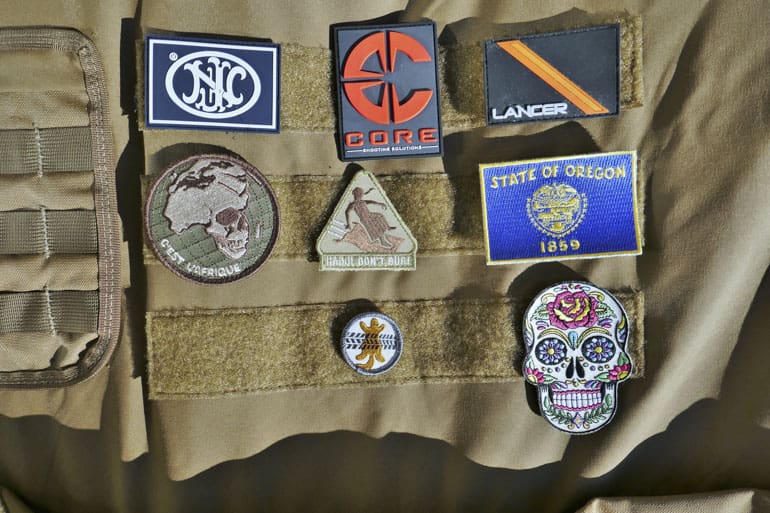
Air Armor includes three 12-inch long strips of Velcro (aka: “hook and loop”) strips so that the user can attach accessories attachment. At the very least, you can use this real estate to display the latest politically-incorrect morale patches that you scored at SHOT Show.
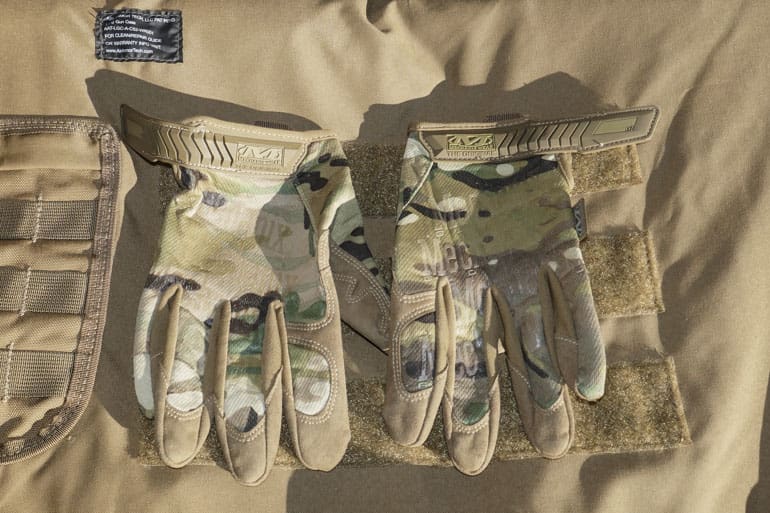
I found the Velcro to be a handy place to store my gloves!
Durability
The big issue that everybody is going ask is: How durable and rugged it is thing? After all, $550 is a lot of money to shell out for a rifle case, and conventional wisdom would suggest that an air bladder can’t possible be very durable.
I’ve been using this case for 18 months and it shows no sign of wearing out or breaking. Now, I wouldn’t purposely throw this case into a cactus patch or a rose bush, but I don’t think you need to baby it.
The Only Big Downside: It’s Not TSA Approved
If you’re a competitive shooter who travels to shooting events, the Air Armor Tech gun cases are not gonna fit the bill, because these cases are not TSA approved. According to Air Armor Tech’s website, they’re working on a model that will meet TSA’s requirements. In the meantime, however, air travelers should look elsewhere.
On the Other Hand, it Floats!
If you get to your favorite hunting spot via a small boat such as a kayak or canoe, then the Air Armor Tech case is a great option. Not only does it float by itself, it can still float when loaded down with 180 lbs. of gear.
This could also be helpful when hunters are conducting river crossings, especially when going after spring bear. I know what you are thinking: How am I supposed to lose all my guns in a “tragic boating accident™” if my rifle case floats?!
Scope Cover
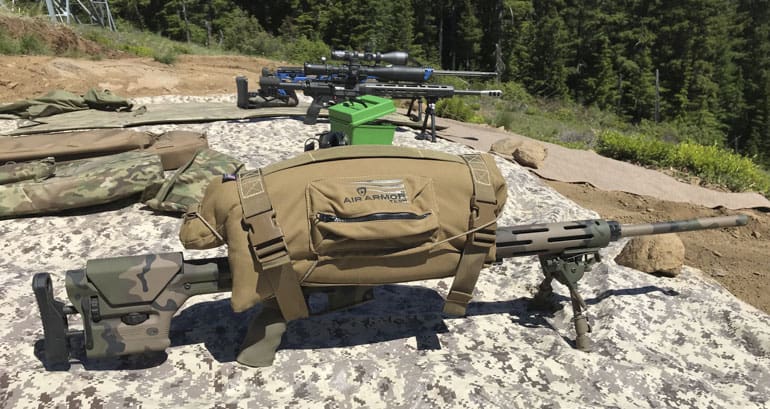
Air Armor Tech also makes a pretty neat 16-oz. scope cover which is great for hunting trips or PRS competitions. In a pinch, it could also double as a positional shooting bag! Heck, I’ve even used it both as a seat when coyote hunting and as a camp pillow.
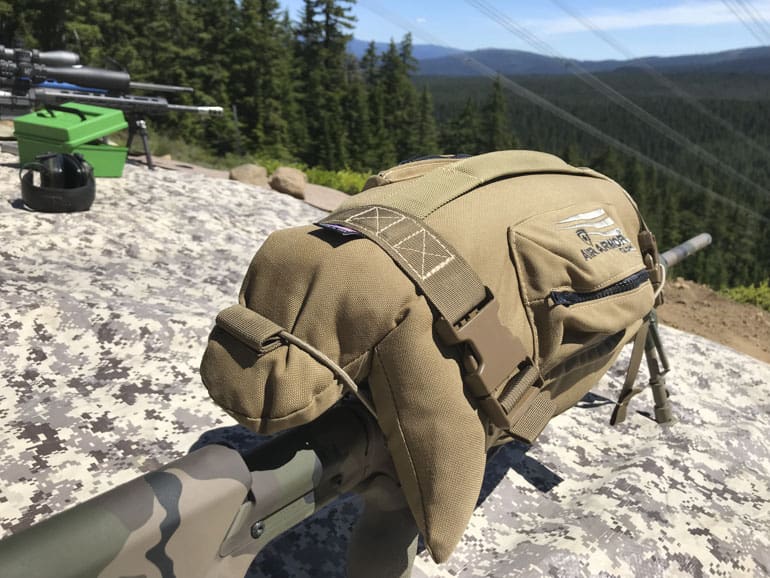
The scope cover is held in place by two large side buckles and can be cinched up with the attached shock cord. One great feature is that you can loosen the shock cord such that you can lift up the case flaps that cover the lenses so the scope can be used without removing the cover.
Obviously, doing so won’t give you access to the parallax adjustment or the elevation and windage turrets, so you would want everything to be pre-set for short-range shots.
Overall, this is a handy and lightweight way to protect that Schmidt + Bender PM II, but not exactly cheap at $250 MSRP.
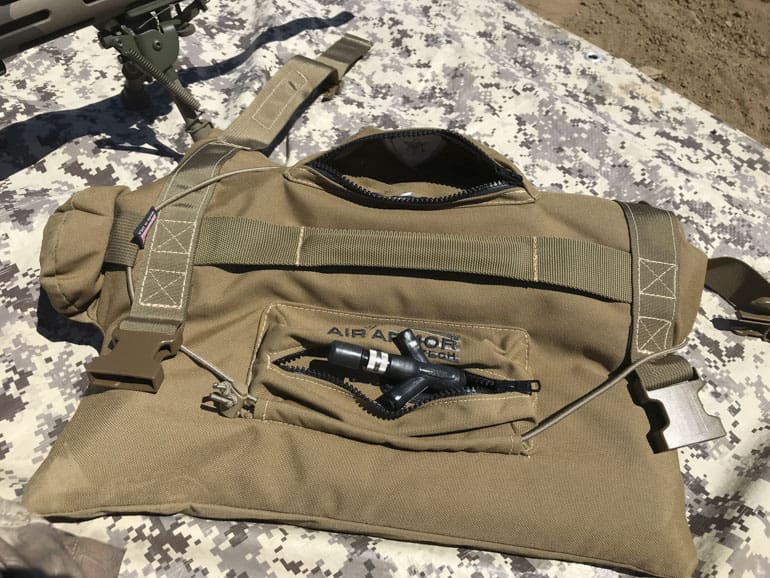
Specifications: Air Amor Tech Long Gun Case
Weight: 10 lbs.
Dimensions: 55’ x 19’ x 7’ (approximate when inflated)
Dimensions: 19” x 10” x 10” (approximate when compressed)
Price: $550
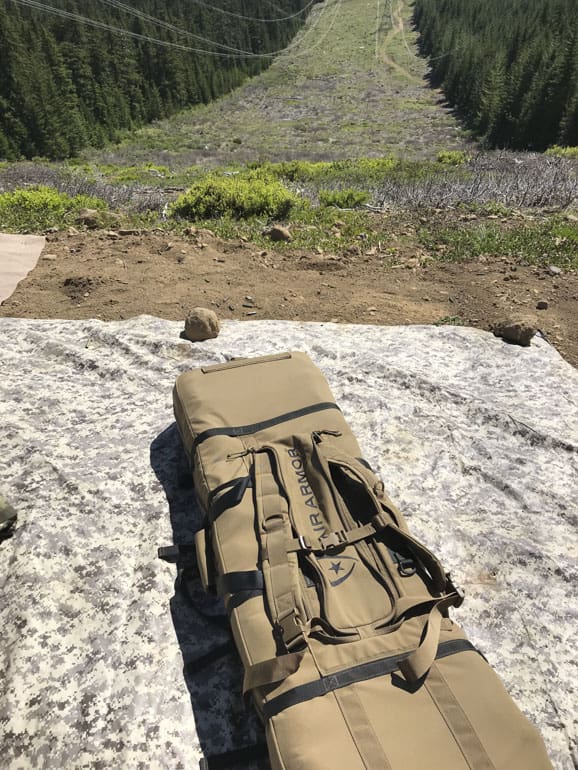
Ratings (out of five stars):
Protection: * * * * *
Despite my initial reservations, I have been pleasantly surprised by the amount of protection that this case provides when it is fully inflated. It is certainly on par with a hard case, and in some respects may actually exceed a hard case.
Durability: * * * * *
Air Armor cases are made in the USA and use top-of-the-line nylon, stitching, etc., which makes for a remarkably durable product. After 18 months of use, my T&E sample looks the same as it did on day one. I didn’t go out of my way to destroy this case, but I didn’t baby it either. I’m convinced it will go the distance so long as you don’t set it down on a cactus.
Value: * *
Admittedly, the $550 price point is cringeworthy, and is going to limit the number of customers. Those who see the utility in a case that stores in a package the size of a small sleeping bag will most appreciate this product. I suspect that Air Armor Tech will one day release a no-frills version of this case that features the same quality and protection, but drops most of the pockets and barrel pouch, etc.
Overall: * * * *
When I first saw this product, I thought it was a solution in search of a problem. But as I started to use this case, I started to appreciate its light weight and the fact that I could store it in a drawer. After 18 months, I find myself using this case more and more, and I’m leaving my heavy Pelicans and Hardiggs in the basement collecting dust.

All images by Joe Grine for TTAG.

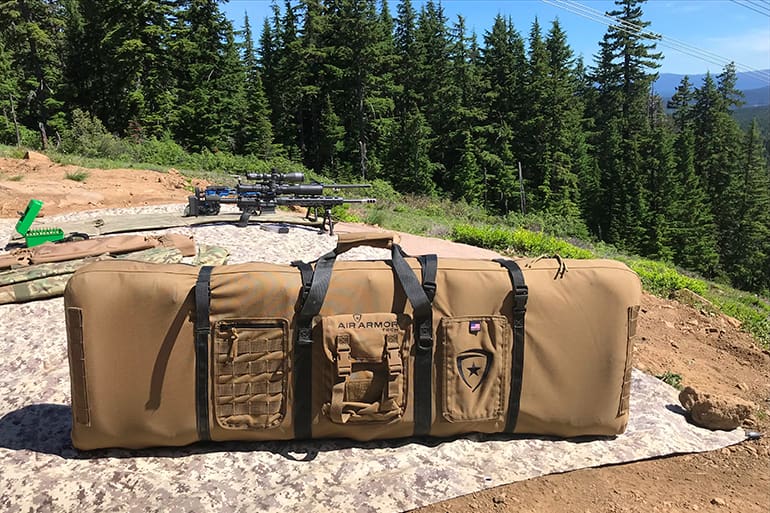



Sounds great for transporting your own stuff, but I think the gun shouldn’t be the main source of rigidity if you are going to let baggage manglers get their hands/equipment on it.
I think most transportation guidelines require hard cases anyway.
Exactly 0% of my inflatable outdoor gear still holds air.
I’ve broken solid cases and torn fabric and foam ones. This particular inflatable case is just safe queen throne for cushy air conditioned suv transport to the range or gun show.
If I had a $10,000 rifle, $550 for its case would be a swinging deal.
The F-16 is a Falcon, not a Viper.
There is an F-16 unit called the Vipers. They even sport patches on their Flight Suits that say “Viper Pilot” on them. That’s most likely what he is referring to.
Also per Wikipedia…
The F-16’s official name is “Fighting Falcon”, but “Viper” is commonly used by its pilots and crews, due to a perceived resemblance to a Viper snake.
I don’t think the price will limit their customer base.
It’s just obvious to me that I am not that customer.
A Ruger American with a Nikon 3×9 gets something a little less puffy.
Nice piece of kit though.
I agree with the comment about the gun being the only structure that’s Ridgid inside the case. Plus the price, I think I’d rather have one with removable foam that I can customize and a hard outside.
damn, spendy. still, worth it. may as well, you got that super nice thing.
So I get that people with expensive firearms can probably afford expensive cases. But other than flotation as protection from a terrible boating accident, an inflatable gun case seems like a short-lived item. Even the best is going to develop a leak or three. These things are, after all, not protected by a hard exterior helmet shell. They are stuffed into car trunks, the backs of SUV’s, aircraft cargo holds, stacked in closets, on gun range rough surfaces and just plain old down on the dirt in forests and mountains. Endless sharp and pointy things will be looking for a way to get all rude and discourteous on that air bladder.
So, nope, wish them all the best but nope, not gonna’ buy that thing.
One of the reasons I waited so long to publish the review is that I was leery about the air bladder. I figured it would eventually leak, frankly. But, 18 months in…. so far, so good. The bladder really is much more durable that I would have imagined.
Ask the manufacturer about replacement air bladders.
Many airplane fuel tanks are bladders. They can be replaced, with effort.
Plano makes pretty decent hard rifle cases at around $80-$100 a piece. FYI for those of you who have a hard time shelling out $500+ for a zippable nylon air baloon. Oh, but it floats!
If the tech protects a $200,000 helmet, it will protect your gun and optics just fine. If the reviewer used it for 18 months and didn’t damage it, most likely neither will you. It is too bad it doesn’t meet TSA requirements, but on the other hand, it compresses down to a carry-on sized volume while you fly your rifle in a rigid TSA approved container (most of which are a joke, really). If you want to protect your long gun while hiking (i.e. not just driving to within 100′) to your hunting camp, this looks ideal. If you are going to travel by boat to your hunting camp, again this is ideal.
Is it pricey? Yes. Is it worth it to keep a hunting trip you’ve spent all year looking forward to, spent thousands of dollars on, using your paid vacation days, from going south because your gun gets damaged or lost in a real boating accident? Probably.
Tragically, all of my firearms have been lost in previous boating accidents, some of them 200′ to the bottom of Lake Powell. I wish that I had had Air Armor Tech’s Inflatable Long Gun Case.
I have a very abused 1000D Cordura pack packed to the gills that I take everywhere – so heavy no one else wants to pick it up, or they put it back down real quick. Still looks mint brand new.Helikon Direct Action Ghost. It just will not fail. Or fade. Or Stain. Or burn. Or flood. I use it as a shooting bag sometimes and no muzzle burns anywhwere.
Jusr for the new folks out there. Owning a firearm today for a responsible gun owner means:
1. Range fees
2. How far do you drive to get to a gun range?
3. Carry permit class.
4. Ammunition cost.
5. Gun storage security.
6. Training class
7. More training classes.
8. If you choose, carry insurance.
9. Holster or holsters
10. Gun belt.
11. Ammo magazines.
12. Safely equipment
13. Gun carry bag.
14. Cleaning kit.
15. Do you have the time?
I believe all this is the minimum you need to have. You will not need a $500 carry case. But you will spend $500 for all of the above. Just to get started.
BTW
You don’t have to do this all at once. I spread it out over a two year period.
Why the focus on beginners? This article is clearly intended for advanced shooters with long range rifles that typically range from $5,000 – $10,000, or sometimes more.
Comments are closed.